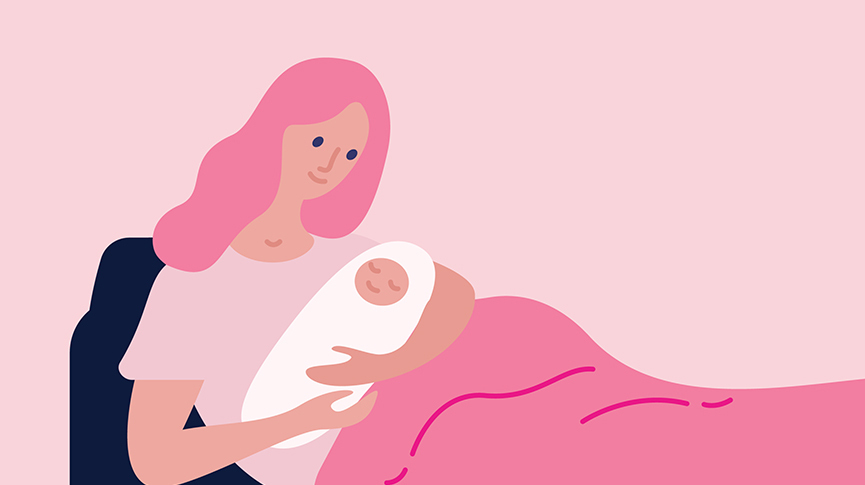Post Birth Care: Cesarean Section

Congratulations! You just grew a human and birthed them from your body!
No matter what exit your new family member took, the fact of the matter is, YOU did it, and you deserve all the celebrations, rest, and space for healing that you desire.
As you may have figured out, birth is unpredictable. So whether a belly birth or C-section was part of your original plan, you have made it through, and now on top of caring for a new baby, you also have your own healing to think about.
You Deserve It
One of the biggest ways you can support your postpartum healing is by preparing ahead of time.
Meal planning and freezing meals, or setting up meal trains. Seeing what resources are available to you in terms of support.
This may mean hiring a postpartum doula, mother’s helper, or recruiting friends and family.
Whoever is coming by, be sure they have a job to do. Whether it be washing dishes, cooking, taking the dog for a walk, or watching the baby while you shower, your job is to heal and be with your baby, not entertain guests.
What to Expect
While this can vary if you experienced any complications during birth and pregnancy, the average recovery time for a C-section is four to six weeks.
Your doctor will probably recommend sitting out of bed in the first 24 hours after surgery, and after that, trying to walk to the toilet. You’ll most likely have a catheter in during surgery, which will be taken out once you’re able to walk to the toilet. Walking is important post-surgery to help prevent blood clots and constipation.
Constipation is common after giving birth. A gentle stool softener or fiber supplement can help ease your constipation worries, and get you back on schedule.
You will most likely be given compression socks in the hospital. These help prevent blood clots in the lungs and legs post birth, as you’re not able to be as mobile as usual.
Remember that a c-section is a major surgery, and it may be difficult to get up or sit out of bed during the first week. This will get better with time.
Avoid lifting anything heavier than your baby, and make plenty of time for rest and bonding, if you’re able to.
You’ll also want to avoid inserting anything into your vagina, like a menstrual cup or penetrative sex, until you get the go-ahead from your doctor, which is usually around six weeks postpartum.
Nursing
If you choose to nurse or body feed your baby, it can be a little trickier to find a comfortable position after a C-section. Typically a football hold and side-lying position are easier to find comfort in for both you and your baby. If you are still having discomfort or issues with lactation, you can consider reaching out to a lactation consultant, or other specialist with experience in this area.
Incision Healing
There are a few different types of incisions used for C-sections, no matter what kind you got, you’ll want to take extra care to help prevent infections along it.
Your doctor will give you clear instructions on how to care for your incision, which may vary depending on what they used to close the wound. The biggest part of that is keeping the incision dry and clean.
They will also be able to tell you what pain medications are appropriate for you and your healing if need be. You can use an ice pack or heating pad on your abdomen and pelvic area for discomfort and itching.
Avoid fully immersing yourself in water until it is fully healed, and opt for a shower, or wiping yourself down.
When it comes to healing ointments, your provider may ask you to keep your incision covered or uncovered. If you are wearing clothes, opt for breathable fabrics.
Your doctor will tell you if you will need to come in to have your sutures or other closure method removed. Although it can be difficult with a new baby, it’s important to go to these appointments to avoid infection, and make sure you’re healing well.
Watch for any signs of infection like redness, swelling, pus, swollen lymph nodes, and fever.
Bleeding
Postpartum vaginal bleeding, or lochia, is normal even after a C-section. This bleeding is mostly from the implantation site where the placenta was attached to your uterine wall.
You may have less vagina bleeding than with vaginal birth, because your obstetrician will manually swab the uterus during your procedure.
That being said, you may need to wear a thick pad or period panties for six to eight weeks postpartum. If you fill up more than a pad every hour, or have clots bigger than a quarter, consult your provider.
It’s Not All About The Belly
If your C-section was unplanned, you may have spent some time in labor, or even started pushing before continuing with a C-section.
In this case, you may experience vaginal soreness, possible tearing, or other fun side effects of labor and birth.
If you’re experiencing discomfort in your pelvic area, vagina, labia, vulva, and/or perineum you can turn to this guide for post vaginal birth care, where we discuss tools and tips like sitz baths and peri bottles.
No matter what your birth journey looked like, you will most likely experience cramping as your uterus returns back to its pre-baby size, a process called involution.
Although it can be difficult to prioritize your healing when caring for a new baby, remember that by caring for yourself, you are also caring for your baby. If you have any doubts about your healing, go ahead and give your healthcare providers a call, they are there to help and support you.
Facts Checked By:

Dr. Shree Datta is a Consultant Obstetrician and Gynaecologist in London, specialising in women’s health including all menstrual problems such as fibroids and endometriosis. Dr. Shree is a keen advocate for patient choice, having written numerous articles and books to promote patient and clinician information. Her vision resonates with INTIMINA, with the common goals of demystifying periods and delivering the best possible care to her patients.
Article written by:

Natasha (she/her) is a full-spectrum doula and health+wellness copywriter. Her work focuses on deconstructing the shame, stigma, and barriers people carry around birth, sex, health, and beyond, to help people navigate through their lives with more education and empowerment. You can connect with Natasha on IG @natasha.s.weiss.


